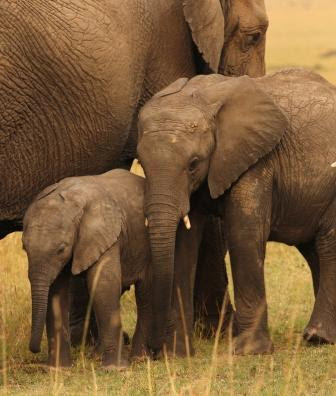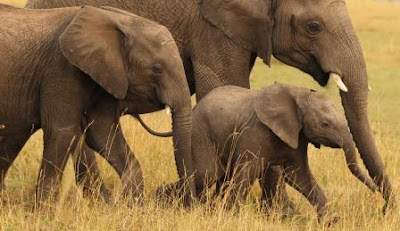 We visited the crater during the last three days of our Masai Mara safari. It was my third visit to this remarkable volcanic bowl and as always proved well worth crossing the border into Tanzania for.
We visited the crater during the last three days of our Masai Mara safari. It was my third visit to this remarkable volcanic bowl and as always proved well worth crossing the border into Tanzania for. It was quite dry there and although the animals in this crater are isolated by the steep crater walls from the vast savannah that surrounds it, the wildebeest still migrate locally.
It was quite dry there and although the animals in this crater are isolated by the steep crater walls from the vast savannah that surrounds it, the wildebeest still migrate locally. Their steady progress made a dramatic picture against the back drop of the salt pan and the crater walls behind.
Their steady progress made a dramatic picture against the back drop of the salt pan and the crater walls behind.  These elephant had clearly been stripping the bark from the yellow fever trees.
These elephant had clearly been stripping the bark from the yellow fever trees. 
Again the steep walls of the crater set the scene each day.
 Black rhino are a rare sight in Kenya and Tanzania, but the Ngoro Ngoro Crater is well-protected and supports a stronghold. There are nearly 30 living in the 10 mile wide crater.
Black rhino are a rare sight in Kenya and Tanzania, but the Ngoro Ngoro Crater is well-protected and supports a stronghold. There are nearly 30 living in the 10 mile wide crater.
 There were plenty of lion there too. This lioness was in season and in a playful mood.
There were plenty of lion there too. This lioness was in season and in a playful mood.  She jumped across a muddy river - hence the 'black stockinged effect up her back legs - to greet another lioness and left a pride male looking rather disgruntled on the other side.
She jumped across a muddy river - hence the 'black stockinged effect up her back legs - to greet another lioness and left a pride male looking rather disgruntled on the other side.
 Black rhino are a rare sight in Kenya and Tanzania, but the Ngoro Ngoro Crater is well-protected and supports a stronghold. There are nearly 30 living in the 10 mile wide crater.
Black rhino are a rare sight in Kenya and Tanzania, but the Ngoro Ngoro Crater is well-protected and supports a stronghold. There are nearly 30 living in the 10 mile wide crater. There were plenty of lion there too. This lioness was in season and in a playful mood.
There were plenty of lion there too. This lioness was in season and in a playful mood.  She jumped across a muddy river - hence the 'black stockinged effect up her back legs - to greet another lioness and left a pride male looking rather disgruntled on the other side.
She jumped across a muddy river - hence the 'black stockinged effect up her back legs - to greet another lioness and left a pride male looking rather disgruntled on the other side.  We came across this year-old cub and his mother. He looked in very poor condition.
We came across this year-old cub and his mother. He looked in very poor condition. I suspect he had been attacked by another lion, or hyenas.
I suspect he had been attacked by another lion, or hyenas. When we stopped at a toilet block we noticed a dead bull buffalo about 70 yards away. He was in too good a condition to have died of disease or age. Then as we all filed out of the toilets we saw this male lion glowering at us.
When we stopped at a toilet block we noticed a dead bull buffalo about 70 yards away. He was in too good a condition to have died of disease or age. Then as we all filed out of the toilets we saw this male lion glowering at us.It was such a fantastic safari that I plan to lead another next year. If you're interested in booking a place click here for more information.







 Ex-PC Mike Pannett on the wildlife beat
Ex-PC Mike Pannett on the wildlife beat
 Special Tophill Low Safari Extravaganza
Special Tophill Low Safari Extravaganza

 There is no hard and fast answer as it will always depend on space and budget, but I have used Canon cameras for 14 years now and over this time I have collected an array of different camera bodies and lenses.
There is no hard and fast answer as it will always depend on space and budget, but I have used Canon cameras for 14 years now and over this time I have collected an array of different camera bodies and lenses. When travelling around weight is always the biggest issue - especially on flights. I usually manage to get a friend or relative to carry a rucksack for me, jammed with gear.
When travelling around weight is always the biggest issue - especially on flights. I usually manage to get a friend or relative to carry a rucksack for me, jammed with gear. If a lens has a huge range of zoom it is usually too good to be true - having said that the 17 - 270
If a lens has a huge range of zoom it is usually too good to be true - having said that the 17 - 270  I wanted to leave you with a few final shots to give you a lasting flavour of this memorable trip.
I wanted to leave you with a few final shots to give you a lasting flavour of this memorable trip.  There was a breeding herd of elephants quite close to our camp and it was wonderful to watch them with their young.
There was a breeding herd of elephants quite close to our camp and it was wonderful to watch them with their young.



 There's nothing like being out on the plains as the sun comes up.
There's nothing like being out on the plains as the sun comes up. We had our breakfasts out on the savannah.
We had our breakfasts out on the savannah.





 Lions detest water so we watched in astonishment when this male stepped into the swollen Talek River. Look out for the full story of his escapade in my column in the Yorkshire Post today.
Lions detest water so we watched in astonishment when this male stepped into the swollen Talek River. Look out for the full story of his escapade in my column in the Yorkshire Post today. The river was in full spate and he lost his footing half way across and had to paddle fiercely against strong currents.
The river was in full spate and he lost his footing half way across and had to paddle fiercely against strong currents.  As he emerged on the other bank, he shook himself down and strode across the plains as if he owned the place.
As he emerged on the other bank, he shook himself down and strode across the plains as if he owned the place.






